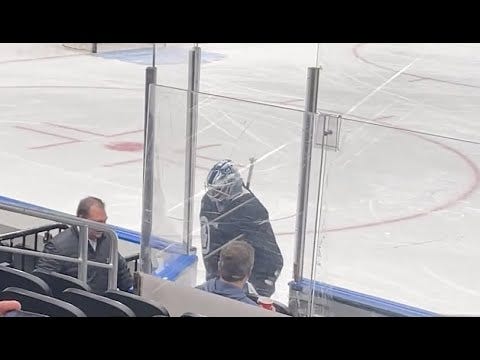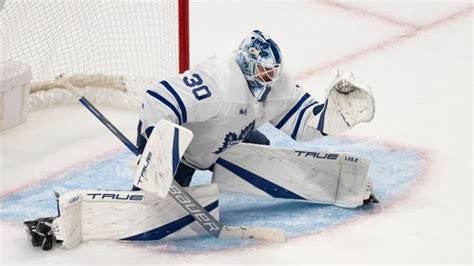As a die-hard Toronto sports fan, the beginning of the National Hockey League season has not been kind to the Maple Leafs. A couple of lazy performances and a pretty significant setback to a key player.
Newly appointed number one goaltender Matt Murray suffered a “lower limb injury”, later to be called a groin strain this past weekend at practice that will sideline him for the next 4-6 weeks. This means 12-18 games for the Leafs without their starting goalie.
Not a good start. Never mind that the Leafs also just lost to the Arizona Coyotes.
What is interesting about the injury is how early in the season (Murray played only one game!) it occurred. This begs the question of his current Point B. As a matter of fact in his 8 year career so far Murray has battled injuries that have kept him out of some action every year since 2017, which begs the question of whether he has ever been at optimal Point B in the last five years.
After the trade to Toronto from the Ottawa Senators, where he only played 47 games in two seasons, it was reported that Murray was spending the summer building his physical capacity through the appropriate training and necessary on ice goaltender skill work. Towards the end of this past summer I had a client tell me after being on the ice with Murray that he looked great, moved well - fast and efficient and that they were expecting him to have a great turnaround season.
It is obvious that he still can, however it is also obvious that the roadmap to prepare him for this needs to be re-routed.
Point B involves having deep wells of four fundamental physical capacities: absolute strength, joint space, reactive strength and speed-strength that all have to be used as feedbacks at the Level of Competition so that the appropriate strength emergences are built into the system.
Point A must also be established. This allows us, as the practitioner, to understand the current state of the athlete. Joint health and function, tissue quality and neurological thresholds are important characteristics to be gathered at this point as is done by the FRA. This paints a picture of how well the internal ecosystem is prepared to allay the demands at the external level.
What Does That Mean for a Goaltender?
Point A
A large requirement for a goaltender is to have very large hip joint workspaces, particularly in the movement zones of flexion and abduction. Specifically with Murray, he plays the butterfly style of goaltending (as do all elite level NHL goalies). In fact, it is rare in today’s NHL to not see a goalie in the butterfly when the puck is around the scoring zones for the offensive team.
I am not an expert in goaltending technique or skill, however this style of goaltending has become the standard “base” position and from there the goalie’s athleticism takes over, allowing them to read and “feel” the game and suit the style to their individualities.
At its core the style mimics a butterfly in that the blocking and catching hands are held close to the body, creating an elevation of the shoulder girdles, maximizing adaptability and net coverage for any high shots that come in. The lower limbs are held together with the knees at 90 degrees and the hips internally rotated, while the goalie maintains a subtle hip hinge. This allows for the legs to flap like butterfly wings on any low shots either from extending the knee while maintaining the hip stacked under the pelvis or by abducting the hip. This allows the goaltender to kick the puck to the sides out of any position where an opposing player can get a rebound opportunity.
As can be seen in the above pictures, this style is incredibly demanding on the spine/pelvis, hips and knees, leading to many potential issues/injuries the goaltender might face.
Anecdotally, I have found most goalies either completely lack or are unable to maintain the necessary joint space at the hips to be effective and efficient in the butterfly over time, which is why they seek treatment. Couple this with a lack of independence between the hip and pelvis as well as the lower lumbar spine and entropy increases leading to disorganization within the system.
I have found less often, dysfunctions at the knee, however it is a joint specific requirement that the knee be able to internally rotate to keep the pad on the ice and allow for quick extension of the knee when necessary.
Point B
Of the Four Fundamental Physical Capacities, goaltenders need an abundance of three, those being joint space, reactive strength and speed-strength to succeed at the Level of Competition (external ecosystem)
Joint Space - Large workspaces are required at the wrists, elbows, shoulders, spine, hips and knees. The position requires the ability to access areas of joint space that are uncommon of other positions to be able to achieve effective posture and positioning, while at the same time being very dynamic and adaptable.
Reactive Strength - Tissue specific strength of connective tissue within the compartments of the legs, pelvis and spine is paramount to the athletic butterfly goaltender. The ability to transition between contraction types (eccentric/concentric) and the ability to transfer force through tissue at length is a key performance factor to play the position effectively.
Speed-Strength - The ability to move fast to block a puck is a large component of todays athletic goaltender simply due to the overall speed of the game, the strategies of attacking players as well as technological advancements in stick composition which allows players to shoot the puck with higher velocities.
Re-Routing the Roadmap for Matt Murray
It is obvious that Matt Murray is not at Point B and has not been for quite sometime.
Knowing the necessary demands of his position and his style allows the practitioner to re-create the road map that would allow him to not only overcome this injury but maintain his health and elite performance for longer periods of time.
Given his recent injury, two fundamental capacities must be considered:
Joint Space
Given the histopathological changes occurring in the injured groin tissue at this time it may be too early to initiate high intensity capsular loading particularly in hip internal rotation. That considered, it would be appropriate to incorporate CARs and specific Capsular CARs in unloaded positions to stimulate the mechanoreceptors of the hip capsular tissue to create an afferent/efferent flow between the hip and the surrounding tissues to maintain available motor neuron pools and to maximize the effects of descending inhibition. Ultimately this would progress to loaded positions as the architectural properties of the medial thigh compartment improve.
Creating available joint space using capsule specific isometric loading at maximal intensities is also necessary, particularly of fundamental motions of the hip (internal/external rotation). Positioning for this could involve the butterfly position incorporated during game play.
Reactive Strength
This is where the majority of re-mapping has to be done considering the groin injury.
There are two important factors to consider: (1) re-establishing length of the tissue and (2) the necessary load bearing capacity of the tissue. For a goaltender this requires maximal length and a very high load bearing tolerance.
To begin, the architectural properties of the medial thigh need to be improved to allow for improved length thresholds and appropriate myofascial force transmission. Specific manual therapy inputs using FR and PAILs accomplishes this goal. These inputs are performed at high frequency initially considering the cellular changes occurring during the first 14 days of the injury.
The goal of reactive strength training is to build the load bearing capacity of connective tissues to improve energy conversion (potential to kinetic) as well as dissipation (minimize internal entropy).
Initially this begins isometrically. As length is created in the adductor compartment isometric loads are scaled into the tissue to initiate the beginning of load bearing capacity, typically done with variations of intensities and times.
Static loading through length and at end range would then have to be moved to dynamic loading through length. This would begin the spectrum of eccentric loading. Again, these are scaled based on length moved through, speed of the movement (slow/fast/overspeed), and the load (or overload).
Increasing the margin of safety of function of the adductor compartment to full length, at full length and progressing at various speeds of movement, is the goal of reactive strength training. Ultimately the adaptive process within reactive strength leads to the tissue specific behaviour(s) that occurs most commonly in the athletes performance.
Off-Season: Acquire Point B & In-Season: Sustain Point B
Herein lies a major conundrum with Matt Murray - he is currently in-season. Not only does he have to rehabilitate an injury but he has to establish a Point B that is more conducive to high performance.
We have stated this prior but is worth repeating - Point B is to be acquired in the offseason and not in-season. This is non-negotiable. Therefore, a simple principle we adhere to at Absolute that dictates the roadmap to training is: in-season the aim of training is to maintain point B whereas in the off-season the aim is to acquire point B.
As an example, in the off-season, training can be sequenced in a logical and progressive manner that acquires joint space over a 3-4 week training wave upon which reactive strength can start to be backfilled within the newly acquired joint space in the next wave. This leads to cumulative simultaneous effects that will compound. This enables the athlete to not only perform the training work at the appropriate intensities to acquire Point B but also enables them to better absorb the training (i.e., continually evolve to Point B) on the back end.
Training for Point B In-Season
In-season compresses both time and training - two essential resources required to attain an optimal Point B. In the specific case of Matt Murray, both joint space and reactive strength need to be trained to acquire simultaneously within-season - not an easy objective, but one that is doable if the practitioner understands how to optimally constrain training intensity for both the acquisition of joint space and connective tissue load bearing capacity.
Suboptimal training scenarios, like the one of Matt Murray, tend to be the norm and not the exception in our dealings with professional athlete management. It is important to understand that if it is your objective to be a practitioner at this level of human performance, you will be dealt these cards and forced to play them — which is why establishing Point A and Point B is essential and constrains the roadmap to achieving an optimal level of. performance.










This article was a pearl. Nice work boys!
Great article! Lots of valuable programming info! Thank you!